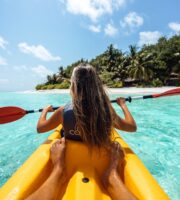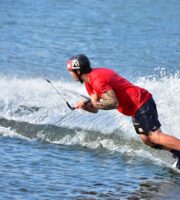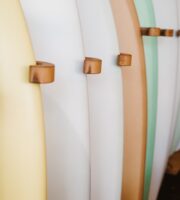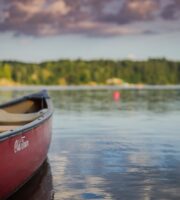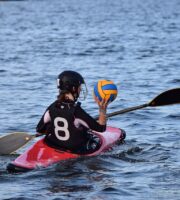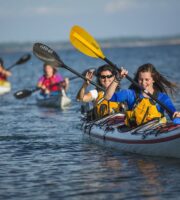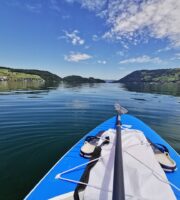If you are puzzled by the question of what you can glide on the water, everything has already been invented before you. Special surfboards are made of wood, ponoplast or fiberglass. Made of these materials boards are very lightweight and durable, which provides excellent maneuverability on the water. Professional surfers do not just drift on a board in the ocean, but catch waves and perform various tricks. Once you catch your wave, you won’t be able to stop again. So let’s figure out what surfing is, what kind of waves there are, and how to keep yourself in shape in the rock jungle.
What you need to know about waves
As we know from school lessons, the wave is formed due to the strength of the wind, also on the strength of the wind will depend on the quality of the wave. There are two types of wind which blow from the shore (offshore) and from the sea (onshore). If the wind is onshore the wave will be unstable and bad, but if the wind blows from the shore, then this wave is already possible to ride. There is also a free wind that is not blowing from the shore or the sea – with such a wind, you will not get good waves to ride.
If there is wind in the ocean, it generates small waves or ripples on the water, which is called chop, with a fairly strong wind wave will be called swell. So, if there is a strong wind, then the swell that appears in the ocean will be called ground-swell, and if the wind forms a wave from the shore, then wind-swell. It is this wave that we need. It is worth to take into account the location of surf spots and the wind trajectory. Thus, the wind and the territorial location will depend on the formation of waves at a particular spot. On the Internet you can find many resources, which are collected lists of surf spots around the world.
Surfboards
There are several kinds of boards, each suitable for a particular style of surfing or individual parameters. Let’s understand what kind of boards there are, and most importantly what they are made of and for what types of surfing:
Longboard – a thick surfboard, the length of such a board can reach up to 10-12 feet (3.0-3.7 meters), depending on the individual needs of the rider. The nose of this board has a rounded shape and suitable for beginner surfers, as riding a big wave with a heavy and clumsy board will not be very convenient or even traumatic for a beginner.
A shortboard is a thin board that is usually no more than 7 feet long. The short and sharp-nosed board allows the rider to perform tricks on the water and even snorkel with ease.
The Funboard is an average class among boards usually no longer than 8 feet long. Based on the name, we can assume that they are the perfect companion for fanboarding. Such a board is great for a beginner just to learn how to catch a wave and surf for fun without complicated tricks.
The gan is a long surfboard with a medium-thick deck. The board has a special shape, very similar to a shortboard, but slightly thicker. Suitable exclusively for pro riders, as having only a solid board underneath you can perform tricks on steep waves.
Tau-in is a short and thin board that has leg bindings for greater stability when conquering big and daring waves. Often surfer on such a board is thrown to dangerous waves by towing with a jet ski (tow-surfing).
Well boards differ not only in shape but in the materials of which they are made. There are boards made of wood, plastic, foam. Have the upper and lower parts, which are very important. The outer side is covered with a special resin (for example, epoxy – epoxy-boards), the thicker this layer of resin, the harder the board will show itself in the work. The main thing to keep in mind is the fact that due to the coating the thickness and weight of the board also increases. The core of a board usually consists of foam and stiffening rib, but it also may be absent. The density of the foam from which the board is made affects the strength and weight of the finished surfboard.
Types of surfing
Surfing can be divided into the concepts of classic and alternative. Classic surfing refers to surfing on the ocean waves, when the rider accelerates to the wave using only his hands and feet, and must gain enough speed to get up on the board.
Alternative surfing can be divided into several types:
Wakesurfing is suitable for those who like to ride a wave but do not have an ocean or sea in their country, as the rider catches the wave from a special towboat. You can ride holding onto the halyard or let it go and glide freely on the wave. If there is no hand tow, for wakesurfing you can use a special panel, which is attached to almost any boat for a minute and forms the necessary wave.
Windsurfing from the English wind. In this case, you can ride by virtue of the wind and the sail, which is attached to the board. Control is by means of the mast and sail.
SUP-surfing acts as a parallel line to the classic surfing. The rider starts moving with the help of the paddle, already in a standing position on the board. Catching waves on a SUP board is not as easy as it may seem from the outside. However, as an advantage over classic surfing, on a SUP you can ride waves with much less amplitude and much longer.
Kitesurfing is a truly extreme and beautiful type of surfing. In open water, the rider performs maneuvers and tricks using the pull of the wind by controlling the kite (kite) attached to the torso.
Tau-surfing is an absolutely extreme way of riding giant waves by towing the rider onto a wave that cannot be caught by paddling out on it “by hand”.
